MG414 Organisational Behaviour: Tesco Practices and Theories Report
VerifiedAdded on 2023/06/18
|12
|3147
|130
Report
AI Summary
This report provides an analysis of Tesco's organizational behaviour, focusing on key theories and models related to motivation, communication, and organizational culture. It explores the application of Maslow's hierarchy of needs and Vroom's expectancy theory for understanding employee motivation within Tesco. The report also examines verbal communication models and directions of communication to assess organizational effectiveness. Furthermore, it delves into Handy's and Schein's models to understand Tesco's organizational culture and its impact on employee motivation and overall performance. The analysis evaluates these practices to provide a comprehensive overview of organizational behaviour within Tesco.
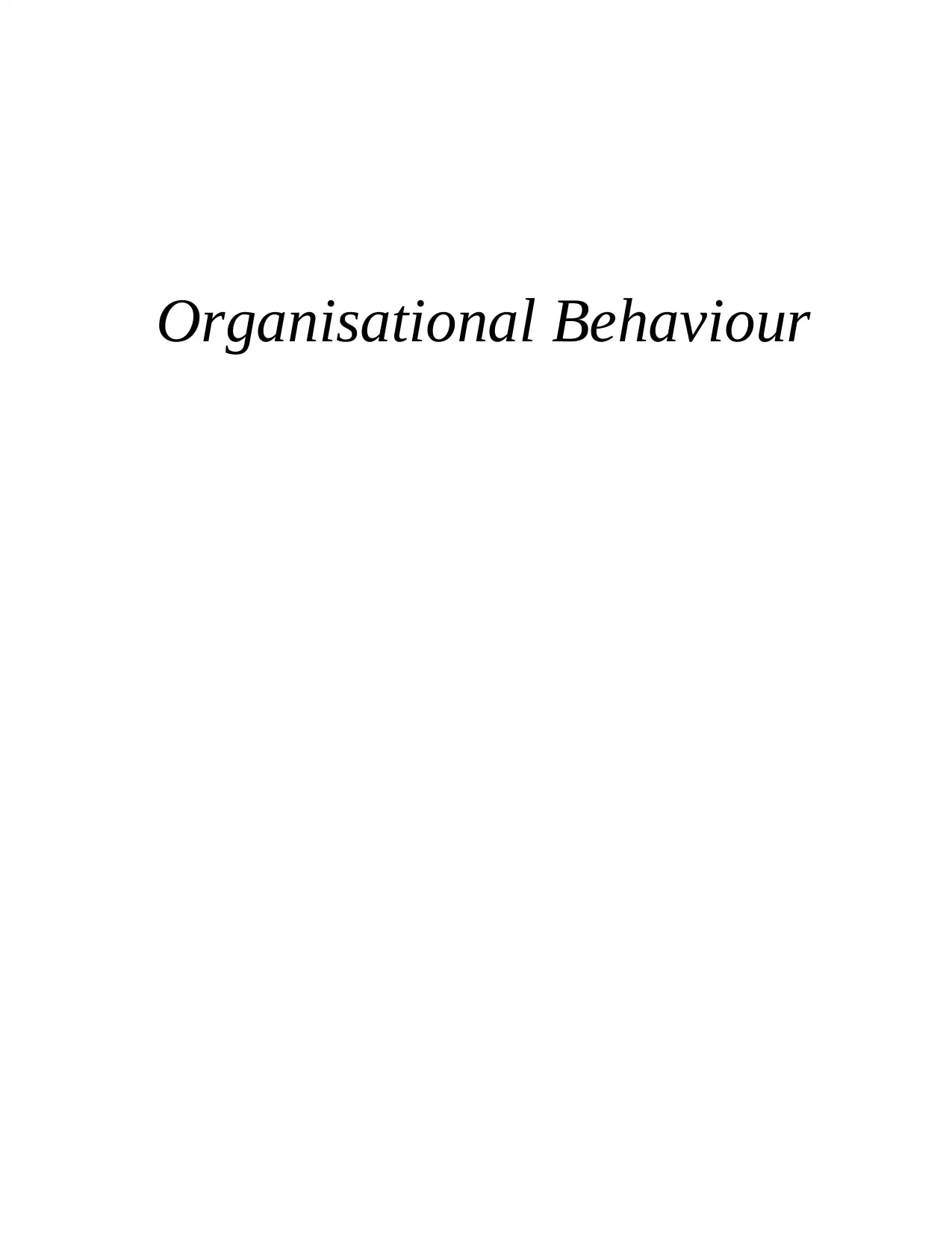
Organisational Behaviour
Paraphrase This Document
Need a fresh take? Get an instant paraphrase of this document with our AI Paraphraser
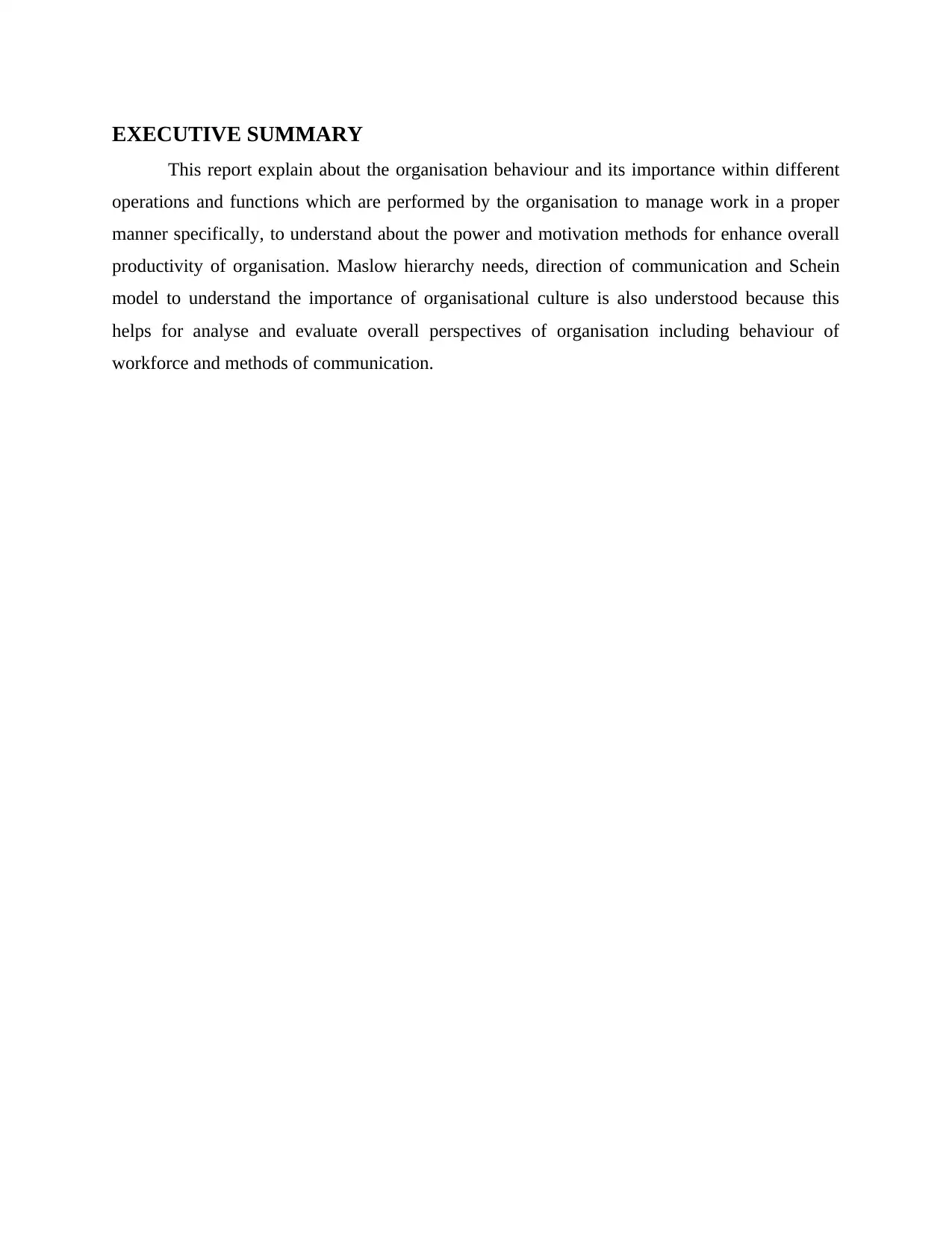
EXECUTIVE SUMMARY
This report explain about the organisation behaviour and its importance within different
operations and functions which are performed by the organisation to manage work in a proper
manner specifically, to understand about the power and motivation methods for enhance overall
productivity of organisation. Maslow hierarchy needs, direction of communication and Schein
model to understand the importance of organisational culture is also understood because this
helps for analyse and evaluate overall perspectives of organisation including behaviour of
workforce and methods of communication.
This report explain about the organisation behaviour and its importance within different
operations and functions which are performed by the organisation to manage work in a proper
manner specifically, to understand about the power and motivation methods for enhance overall
productivity of organisation. Maslow hierarchy needs, direction of communication and Schein
model to understand the importance of organisational culture is also understood because this
helps for analyse and evaluate overall perspectives of organisation including behaviour of
workforce and methods of communication.
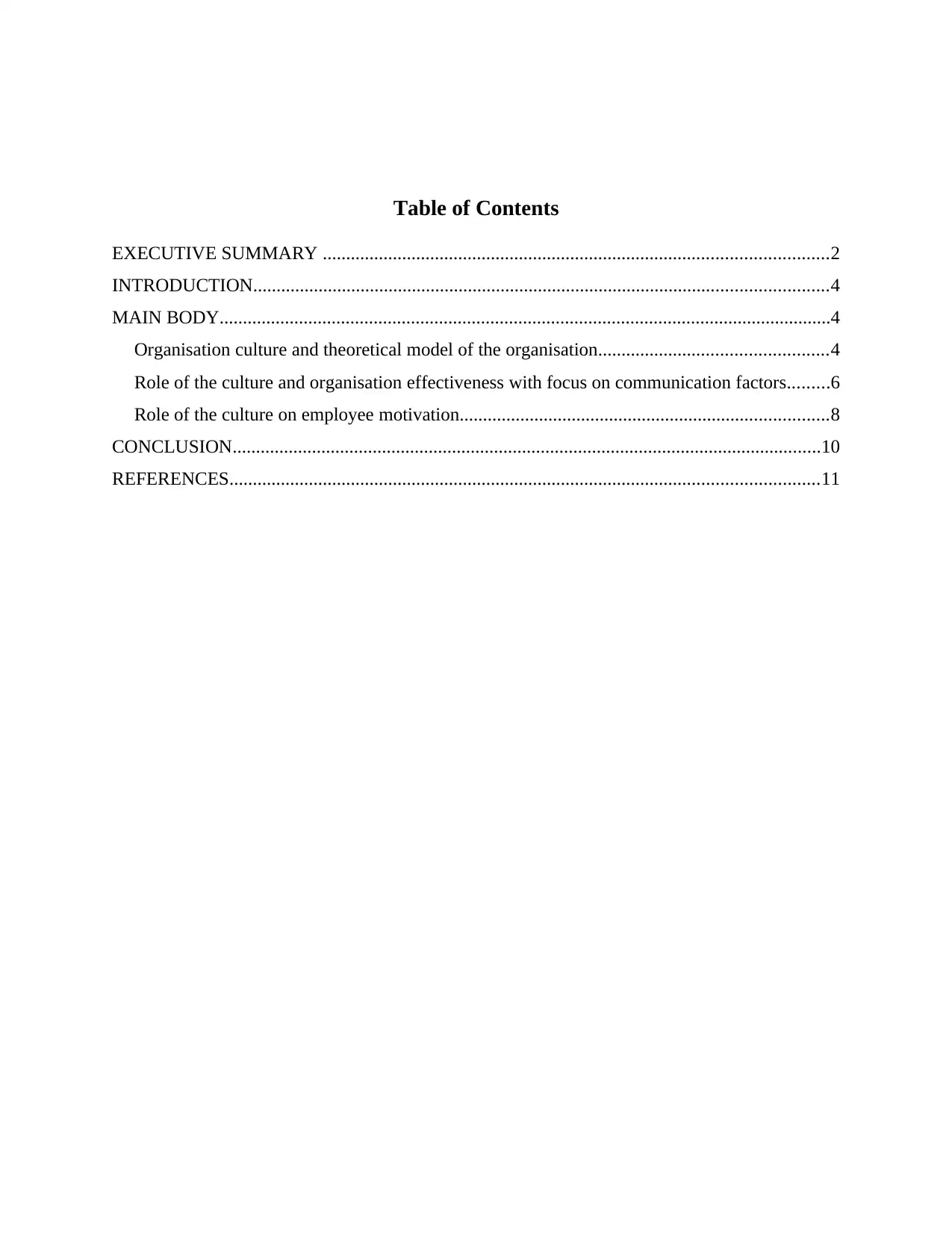
Table of Contents
EXECUTIVE SUMMARY ............................................................................................................2
INTRODUCTION...........................................................................................................................4
MAIN BODY...................................................................................................................................4
Organisation culture and theoretical model of the organisation.................................................4
Role of the culture and organisation effectiveness with focus on communication factors.........6
Role of the culture on employee motivation...............................................................................8
CONCLUSION..............................................................................................................................10
REFERENCES..............................................................................................................................11
EXECUTIVE SUMMARY ............................................................................................................2
INTRODUCTION...........................................................................................................................4
MAIN BODY...................................................................................................................................4
Organisation culture and theoretical model of the organisation.................................................4
Role of the culture and organisation effectiveness with focus on communication factors.........6
Role of the culture on employee motivation...............................................................................8
CONCLUSION..............................................................................................................................10
REFERENCES..............................................................................................................................11
⊘ This is a preview!⊘
Do you want full access?
Subscribe today to unlock all pages.

Trusted by 1+ million students worldwide
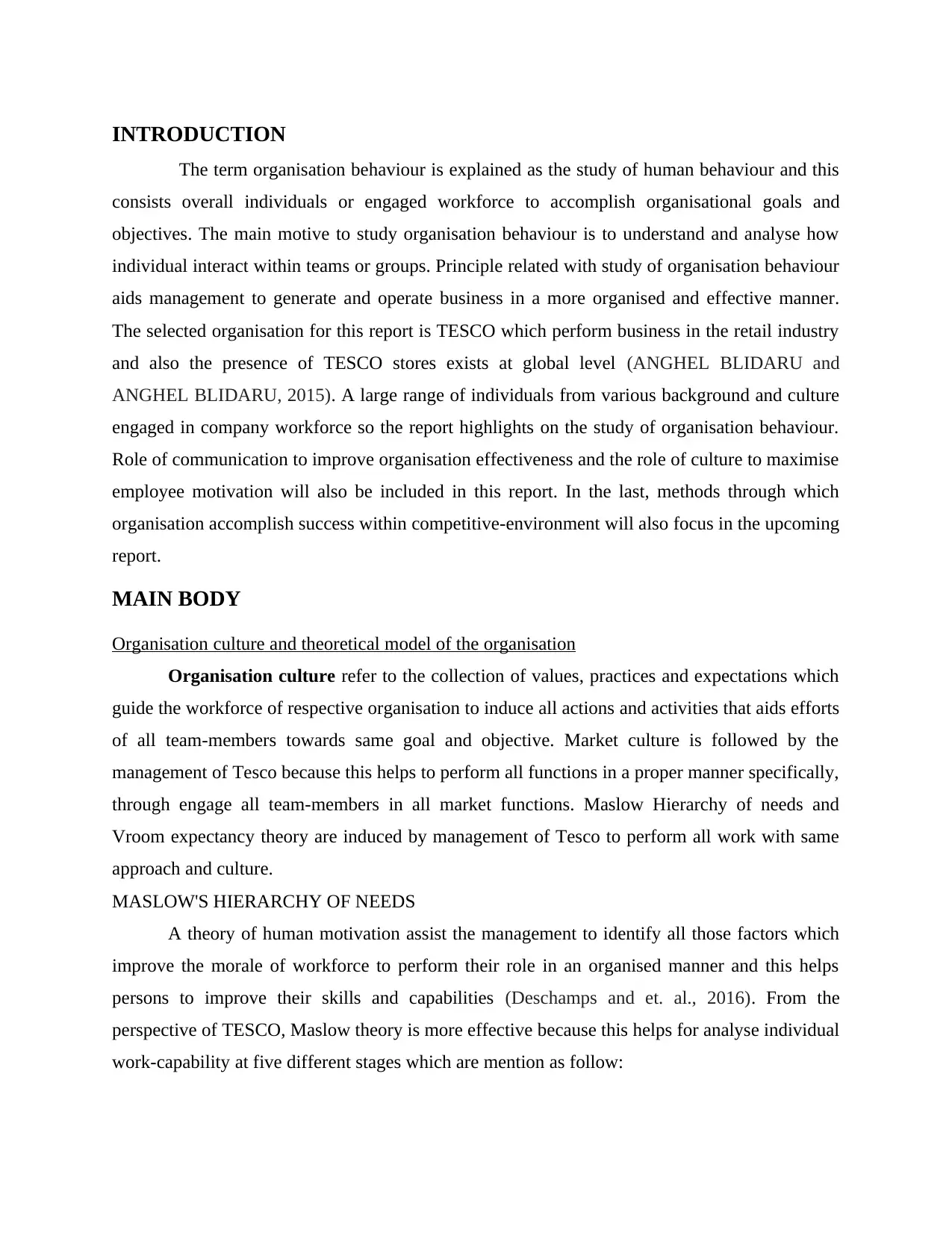
INTRODUCTION
The term organisation behaviour is explained as the study of human behaviour and this
consists overall individuals or engaged workforce to accomplish organisational goals and
objectives. The main motive to study organisation behaviour is to understand and analyse how
individual interact within teams or groups. Principle related with study of organisation behaviour
aids management to generate and operate business in a more organised and effective manner.
The selected organisation for this report is TESCO which perform business in the retail industry
and also the presence of TESCO stores exists at global level (ANGHEL BLIDARU and
ANGHEL BLIDARU, 2015). A large range of individuals from various background and culture
engaged in company workforce so the report highlights on the study of organisation behaviour.
Role of communication to improve organisation effectiveness and the role of culture to maximise
employee motivation will also be included in this report. In the last, methods through which
organisation accomplish success within competitive-environment will also focus in the upcoming
report.
MAIN BODY
Organisation culture and theoretical model of the organisation
Organisation culture refer to the collection of values, practices and expectations which
guide the workforce of respective organisation to induce all actions and activities that aids efforts
of all team-members towards same goal and objective. Market culture is followed by the
management of Tesco because this helps to perform all functions in a proper manner specifically,
through engage all team-members in all market functions. Maslow Hierarchy of needs and
Vroom expectancy theory are induced by management of Tesco to perform all work with same
approach and culture.
MASLOW'S HIERARCHY OF NEEDS
A theory of human motivation assist the management to identify all those factors which
improve the morale of workforce to perform their role in an organised manner and this helps
persons to improve their skills and capabilities (Deschamps and et. al., 2016). From the
perspective of TESCO, Maslow theory is more effective because this helps for analyse individual
work-capability at five different stages which are mention as follow:
The term organisation behaviour is explained as the study of human behaviour and this
consists overall individuals or engaged workforce to accomplish organisational goals and
objectives. The main motive to study organisation behaviour is to understand and analyse how
individual interact within teams or groups. Principle related with study of organisation behaviour
aids management to generate and operate business in a more organised and effective manner.
The selected organisation for this report is TESCO which perform business in the retail industry
and also the presence of TESCO stores exists at global level (ANGHEL BLIDARU and
ANGHEL BLIDARU, 2015). A large range of individuals from various background and culture
engaged in company workforce so the report highlights on the study of organisation behaviour.
Role of communication to improve organisation effectiveness and the role of culture to maximise
employee motivation will also be included in this report. In the last, methods through which
organisation accomplish success within competitive-environment will also focus in the upcoming
report.
MAIN BODY
Organisation culture and theoretical model of the organisation
Organisation culture refer to the collection of values, practices and expectations which
guide the workforce of respective organisation to induce all actions and activities that aids efforts
of all team-members towards same goal and objective. Market culture is followed by the
management of Tesco because this helps to perform all functions in a proper manner specifically,
through engage all team-members in all market functions. Maslow Hierarchy of needs and
Vroom expectancy theory are induced by management of Tesco to perform all work with same
approach and culture.
MASLOW'S HIERARCHY OF NEEDS
A theory of human motivation assist the management to identify all those factors which
improve the morale of workforce to perform their role in an organised manner and this helps
persons to improve their skills and capabilities (Deschamps and et. al., 2016). From the
perspective of TESCO, Maslow theory is more effective because this helps for analyse individual
work-capability at five different stages which are mention as follow:
Paraphrase This Document
Need a fresh take? Get an instant paraphrase of this document with our AI Paraphraser
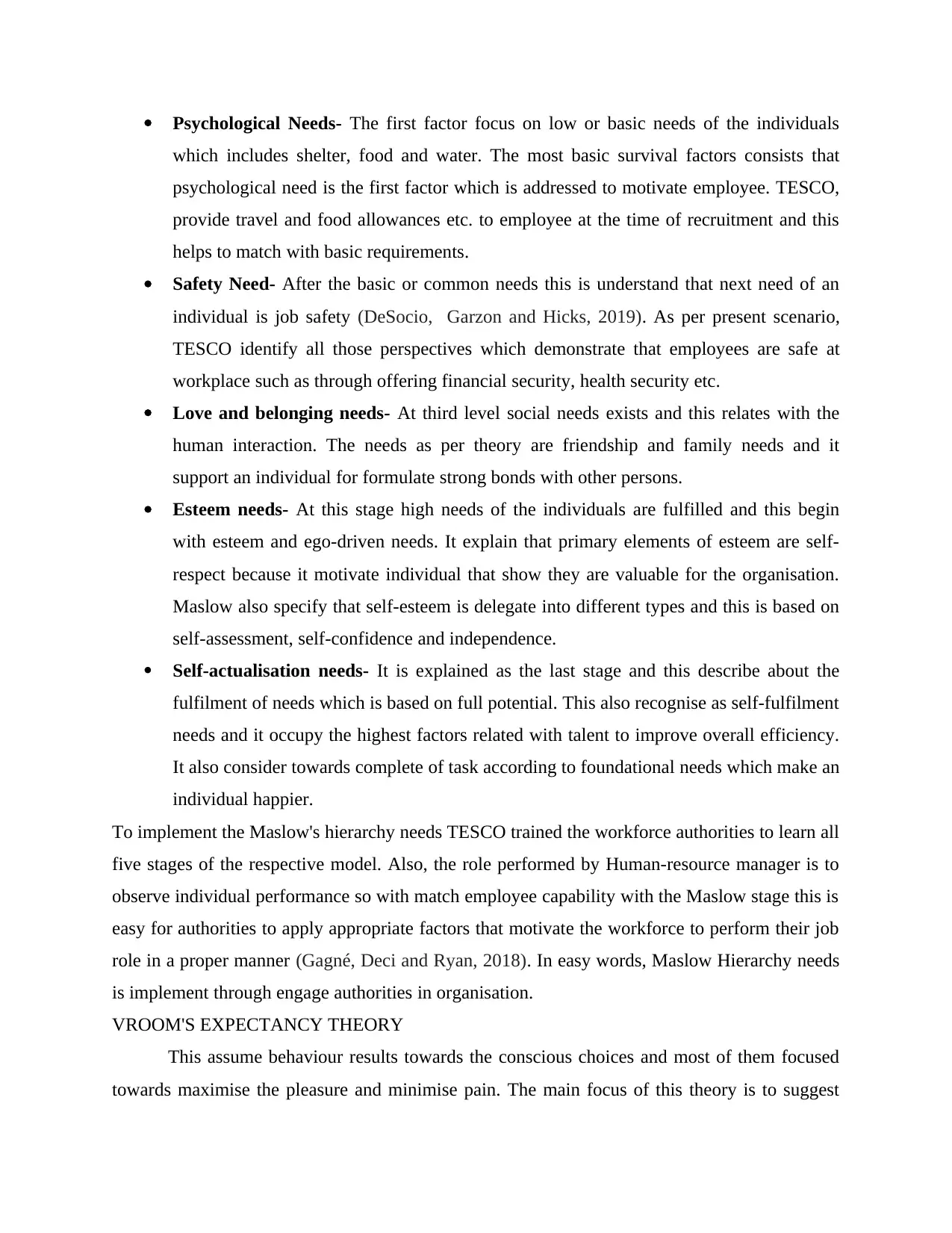
Psychological Needs- The first factor focus on low or basic needs of the individuals
which includes shelter, food and water. The most basic survival factors consists that
psychological need is the first factor which is addressed to motivate employee. TESCO,
provide travel and food allowances etc. to employee at the time of recruitment and this
helps to match with basic requirements.
Safety Need- After the basic or common needs this is understand that next need of an
individual is job safety (DeSocio, Garzon and Hicks, 2019). As per present scenario,
TESCO identify all those perspectives which demonstrate that employees are safe at
workplace such as through offering financial security, health security etc.
Love and belonging needs- At third level social needs exists and this relates with the
human interaction. The needs as per theory are friendship and family needs and it
support an individual for formulate strong bonds with other persons.
Esteem needs- At this stage high needs of the individuals are fulfilled and this begin
with esteem and ego-driven needs. It explain that primary elements of esteem are self-
respect because it motivate individual that show they are valuable for the organisation.
Maslow also specify that self-esteem is delegate into different types and this is based on
self-assessment, self-confidence and independence.
Self-actualisation needs- It is explained as the last stage and this describe about the
fulfilment of needs which is based on full potential. This also recognise as self-fulfilment
needs and it occupy the highest factors related with talent to improve overall efficiency.
It also consider towards complete of task according to foundational needs which make an
individual happier.
To implement the Maslow's hierarchy needs TESCO trained the workforce authorities to learn all
five stages of the respective model. Also, the role performed by Human-resource manager is to
observe individual performance so with match employee capability with the Maslow stage this is
easy for authorities to apply appropriate factors that motivate the workforce to perform their job
role in a proper manner (Gagné, Deci and Ryan, 2018). In easy words, Maslow Hierarchy needs
is implement through engage authorities in organisation.
VROOM'S EXPECTANCY THEORY
This assume behaviour results towards the conscious choices and most of them focused
towards maximise the pleasure and minimise pain. The main focus of this theory is to suggest
which includes shelter, food and water. The most basic survival factors consists that
psychological need is the first factor which is addressed to motivate employee. TESCO,
provide travel and food allowances etc. to employee at the time of recruitment and this
helps to match with basic requirements.
Safety Need- After the basic or common needs this is understand that next need of an
individual is job safety (DeSocio, Garzon and Hicks, 2019). As per present scenario,
TESCO identify all those perspectives which demonstrate that employees are safe at
workplace such as through offering financial security, health security etc.
Love and belonging needs- At third level social needs exists and this relates with the
human interaction. The needs as per theory are friendship and family needs and it
support an individual for formulate strong bonds with other persons.
Esteem needs- At this stage high needs of the individuals are fulfilled and this begin
with esteem and ego-driven needs. It explain that primary elements of esteem are self-
respect because it motivate individual that show they are valuable for the organisation.
Maslow also specify that self-esteem is delegate into different types and this is based on
self-assessment, self-confidence and independence.
Self-actualisation needs- It is explained as the last stage and this describe about the
fulfilment of needs which is based on full potential. This also recognise as self-fulfilment
needs and it occupy the highest factors related with talent to improve overall efficiency.
It also consider towards complete of task according to foundational needs which make an
individual happier.
To implement the Maslow's hierarchy needs TESCO trained the workforce authorities to learn all
five stages of the respective model. Also, the role performed by Human-resource manager is to
observe individual performance so with match employee capability with the Maslow stage this is
easy for authorities to apply appropriate factors that motivate the workforce to perform their job
role in a proper manner (Gagné, Deci and Ryan, 2018). In easy words, Maslow Hierarchy needs
is implement through engage authorities in organisation.
VROOM'S EXPECTANCY THEORY
This assume behaviour results towards the conscious choices and most of them focused
towards maximise the pleasure and minimise pain. The main focus of this theory is to suggest
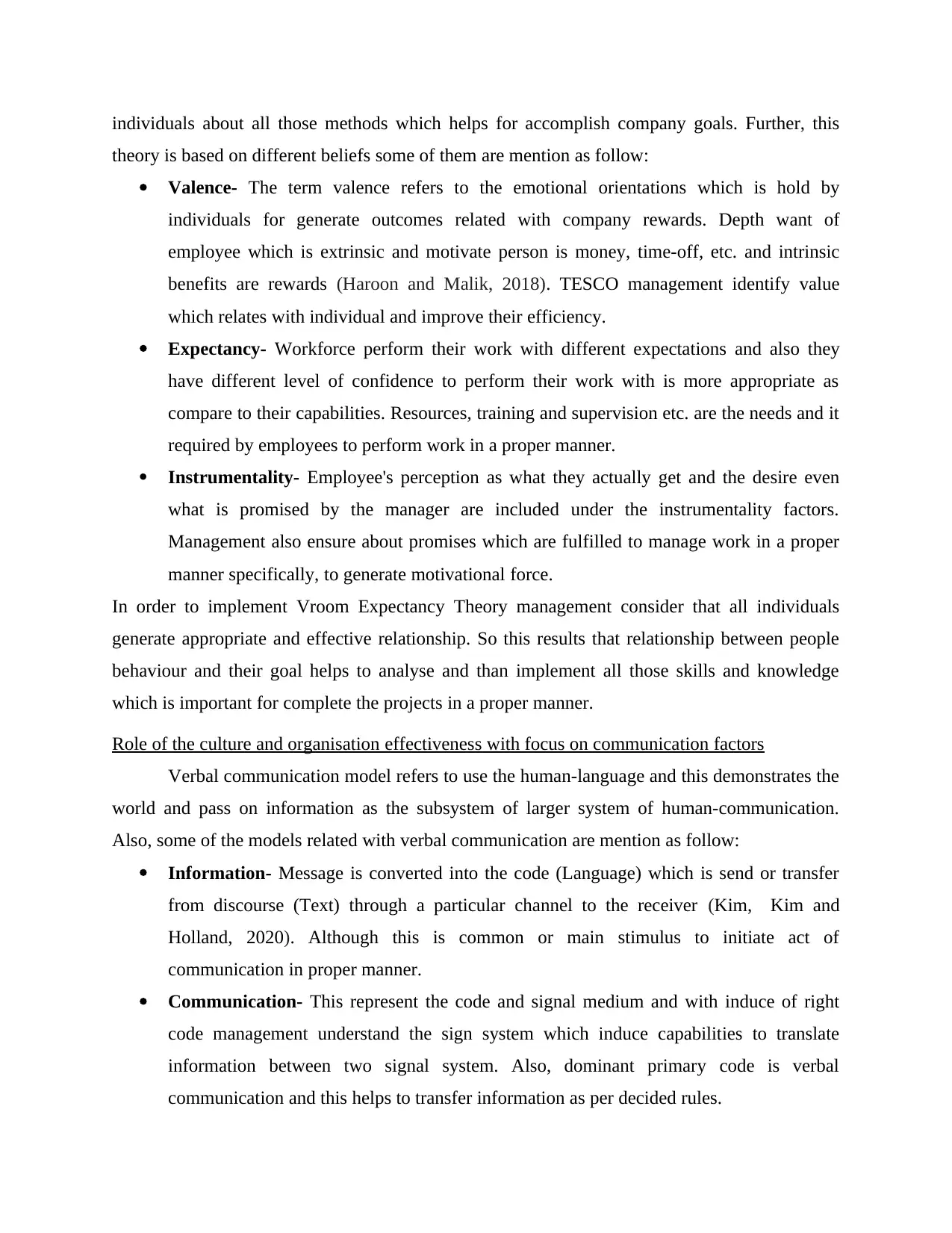
individuals about all those methods which helps for accomplish company goals. Further, this
theory is based on different beliefs some of them are mention as follow:
Valence- The term valence refers to the emotional orientations which is hold by
individuals for generate outcomes related with company rewards. Depth want of
employee which is extrinsic and motivate person is money, time-off, etc. and intrinsic
benefits are rewards (Haroon and Malik, 2018). TESCO management identify value
which relates with individual and improve their efficiency.
Expectancy- Workforce perform their work with different expectations and also they
have different level of confidence to perform their work with is more appropriate as
compare to their capabilities. Resources, training and supervision etc. are the needs and it
required by employees to perform work in a proper manner.
Instrumentality- Employee's perception as what they actually get and the desire even
what is promised by the manager are included under the instrumentality factors.
Management also ensure about promises which are fulfilled to manage work in a proper
manner specifically, to generate motivational force.
In order to implement Vroom Expectancy Theory management consider that all individuals
generate appropriate and effective relationship. So this results that relationship between people
behaviour and their goal helps to analyse and than implement all those skills and knowledge
which is important for complete the projects in a proper manner.
Role of the culture and organisation effectiveness with focus on communication factors
Verbal communication model refers to use the human-language and this demonstrates the
world and pass on information as the subsystem of larger system of human-communication.
Also, some of the models related with verbal communication are mention as follow:
Information- Message is converted into the code (Language) which is send or transfer
from discourse (Text) through a particular channel to the receiver (Kim, Kim and
Holland, 2020). Although this is common or main stimulus to initiate act of
communication in proper manner.
Communication- This represent the code and signal medium and with induce of right
code management understand the sign system which induce capabilities to translate
information between two signal system. Also, dominant primary code is verbal
communication and this helps to transfer information as per decided rules.
theory is based on different beliefs some of them are mention as follow:
Valence- The term valence refers to the emotional orientations which is hold by
individuals for generate outcomes related with company rewards. Depth want of
employee which is extrinsic and motivate person is money, time-off, etc. and intrinsic
benefits are rewards (Haroon and Malik, 2018). TESCO management identify value
which relates with individual and improve their efficiency.
Expectancy- Workforce perform their work with different expectations and also they
have different level of confidence to perform their work with is more appropriate as
compare to their capabilities. Resources, training and supervision etc. are the needs and it
required by employees to perform work in a proper manner.
Instrumentality- Employee's perception as what they actually get and the desire even
what is promised by the manager are included under the instrumentality factors.
Management also ensure about promises which are fulfilled to manage work in a proper
manner specifically, to generate motivational force.
In order to implement Vroom Expectancy Theory management consider that all individuals
generate appropriate and effective relationship. So this results that relationship between people
behaviour and their goal helps to analyse and than implement all those skills and knowledge
which is important for complete the projects in a proper manner.
Role of the culture and organisation effectiveness with focus on communication factors
Verbal communication model refers to use the human-language and this demonstrates the
world and pass on information as the subsystem of larger system of human-communication.
Also, some of the models related with verbal communication are mention as follow:
Information- Message is converted into the code (Language) which is send or transfer
from discourse (Text) through a particular channel to the receiver (Kim, Kim and
Holland, 2020). Although this is common or main stimulus to initiate act of
communication in proper manner.
Communication- This represent the code and signal medium and with induce of right
code management understand the sign system which induce capabilities to translate
information between two signal system. Also, dominant primary code is verbal
communication and this helps to transfer information as per decided rules.
⊘ This is a preview!⊘
Do you want full access?
Subscribe today to unlock all pages.

Trusted by 1+ million students worldwide
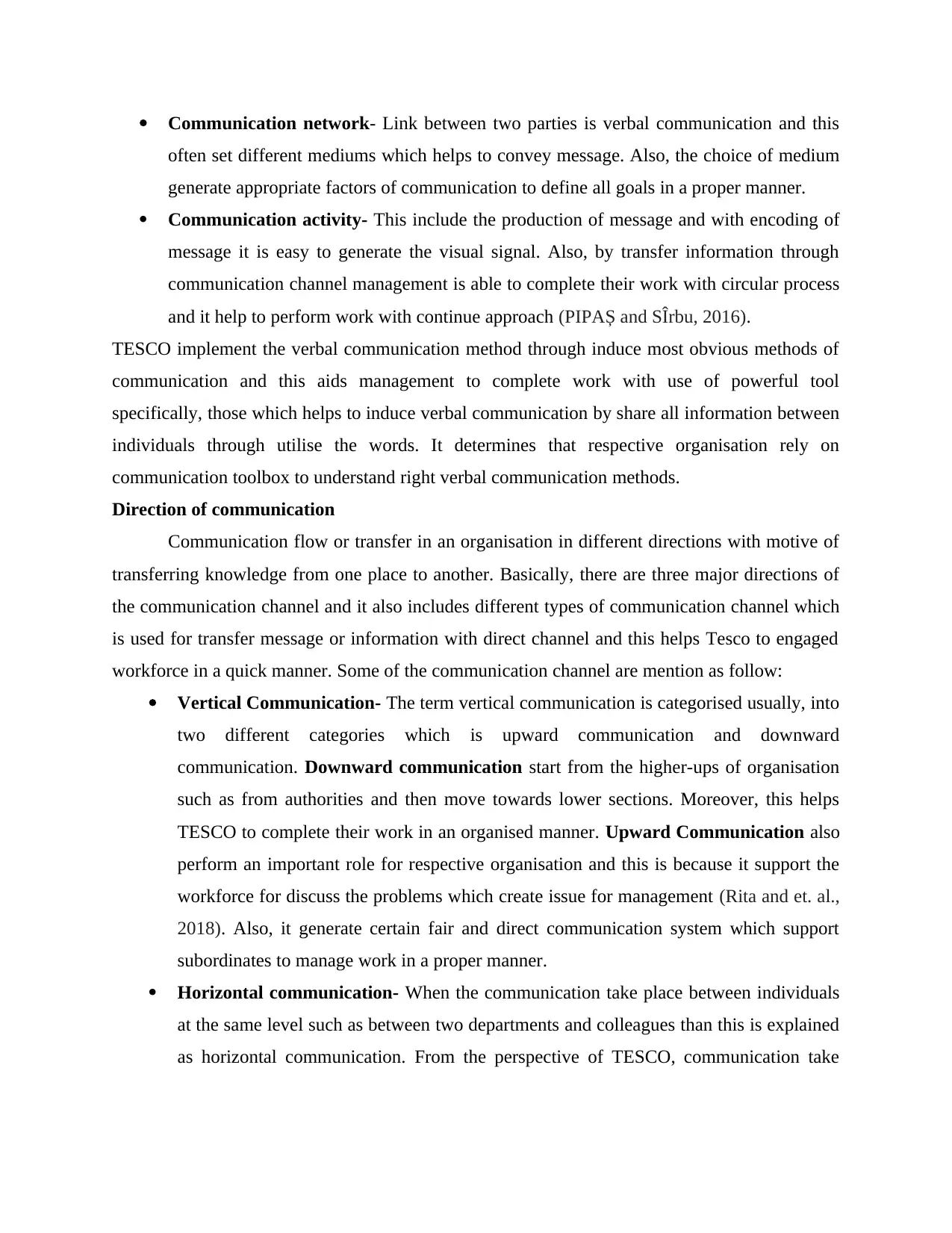
Communication network- Link between two parties is verbal communication and this
often set different mediums which helps to convey message. Also, the choice of medium
generate appropriate factors of communication to define all goals in a proper manner.
Communication activity- This include the production of message and with encoding of
message it is easy to generate the visual signal. Also, by transfer information through
communication channel management is able to complete their work with circular process
and it help to perform work with continue approach (PIPAȘ and SÎrbu, 2016).
TESCO implement the verbal communication method through induce most obvious methods of
communication and this aids management to complete work with use of powerful tool
specifically, those which helps to induce verbal communication by share all information between
individuals through utilise the words. It determines that respective organisation rely on
communication toolbox to understand right verbal communication methods.
Direction of communication
Communication flow or transfer in an organisation in different directions with motive of
transferring knowledge from one place to another. Basically, there are three major directions of
the communication channel and it also includes different types of communication channel which
is used for transfer message or information with direct channel and this helps Tesco to engaged
workforce in a quick manner. Some of the communication channel are mention as follow:
Vertical Communication- The term vertical communication is categorised usually, into
two different categories which is upward communication and downward
communication. Downward communication start from the higher-ups of organisation
such as from authorities and then move towards lower sections. Moreover, this helps
TESCO to complete their work in an organised manner. Upward Communication also
perform an important role for respective organisation and this is because it support the
workforce for discuss the problems which create issue for management (Rita and et. al.,
2018). Also, it generate certain fair and direct communication system which support
subordinates to manage work in a proper manner.
Horizontal communication- When the communication take place between individuals
at the same level such as between two departments and colleagues than this is explained
as horizontal communication. From the perspective of TESCO, communication take
often set different mediums which helps to convey message. Also, the choice of medium
generate appropriate factors of communication to define all goals in a proper manner.
Communication activity- This include the production of message and with encoding of
message it is easy to generate the visual signal. Also, by transfer information through
communication channel management is able to complete their work with circular process
and it help to perform work with continue approach (PIPAȘ and SÎrbu, 2016).
TESCO implement the verbal communication method through induce most obvious methods of
communication and this aids management to complete work with use of powerful tool
specifically, those which helps to induce verbal communication by share all information between
individuals through utilise the words. It determines that respective organisation rely on
communication toolbox to understand right verbal communication methods.
Direction of communication
Communication flow or transfer in an organisation in different directions with motive of
transferring knowledge from one place to another. Basically, there are three major directions of
the communication channel and it also includes different types of communication channel which
is used for transfer message or information with direct channel and this helps Tesco to engaged
workforce in a quick manner. Some of the communication channel are mention as follow:
Vertical Communication- The term vertical communication is categorised usually, into
two different categories which is upward communication and downward
communication. Downward communication start from the higher-ups of organisation
such as from authorities and then move towards lower sections. Moreover, this helps
TESCO to complete their work in an organised manner. Upward Communication also
perform an important role for respective organisation and this is because it support the
workforce for discuss the problems which create issue for management (Rita and et. al.,
2018). Also, it generate certain fair and direct communication system which support
subordinates to manage work in a proper manner.
Horizontal communication- When the communication take place between individuals
at the same level such as between two departments and colleagues than this is explained
as horizontal communication. From the perspective of TESCO, communication take
Paraphrase This Document
Need a fresh take? Get an instant paraphrase of this document with our AI Paraphraser
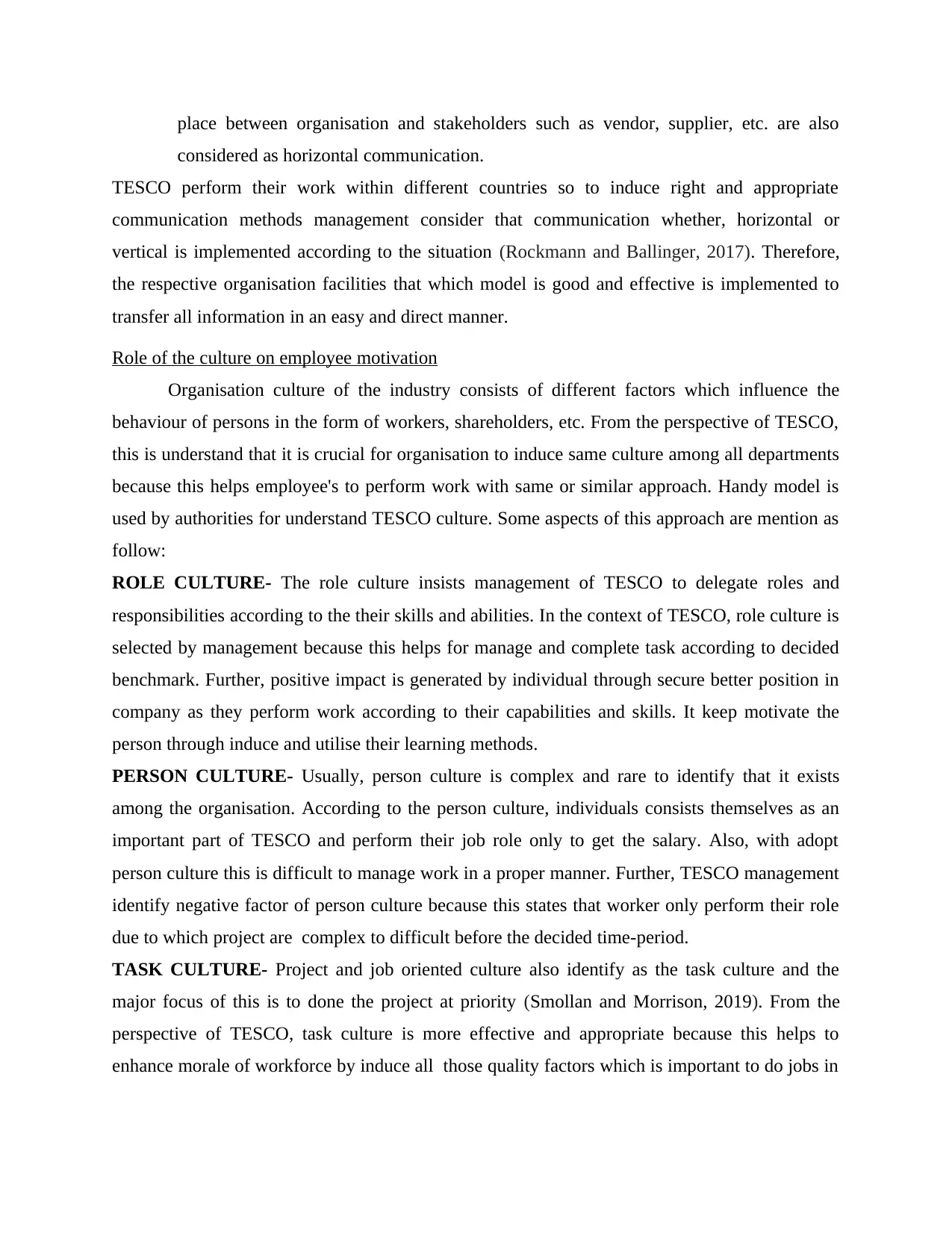
place between organisation and stakeholders such as vendor, supplier, etc. are also
considered as horizontal communication.
TESCO perform their work within different countries so to induce right and appropriate
communication methods management consider that communication whether, horizontal or
vertical is implemented according to the situation (Rockmann and Ballinger, 2017). Therefore,
the respective organisation facilities that which model is good and effective is implemented to
transfer all information in an easy and direct manner.
Role of the culture on employee motivation
Organisation culture of the industry consists of different factors which influence the
behaviour of persons in the form of workers, shareholders, etc. From the perspective of TESCO,
this is understand that it is crucial for organisation to induce same culture among all departments
because this helps employee's to perform work with same or similar approach. Handy model is
used by authorities for understand TESCO culture. Some aspects of this approach are mention as
follow:
ROLE CULTURE- The role culture insists management of TESCO to delegate roles and
responsibilities according to the their skills and abilities. In the context of TESCO, role culture is
selected by management because this helps for manage and complete task according to decided
benchmark. Further, positive impact is generated by individual through secure better position in
company as they perform work according to their capabilities and skills. It keep motivate the
person through induce and utilise their learning methods.
PERSON CULTURE- Usually, person culture is complex and rare to identify that it exists
among the organisation. According to the person culture, individuals consists themselves as an
important part of TESCO and perform their job role only to get the salary. Also, with adopt
person culture this is difficult to manage work in a proper manner. Further, TESCO management
identify negative factor of person culture because this states that worker only perform their role
due to which project are complex to difficult before the decided time-period.
TASK CULTURE- Project and job oriented culture also identify as the task culture and the
major focus of this is to done the project at priority (Smollan and Morrison, 2019). From the
perspective of TESCO, task culture is more effective and appropriate because this helps to
enhance morale of workforce by induce all those quality factors which is important to do jobs in
considered as horizontal communication.
TESCO perform their work within different countries so to induce right and appropriate
communication methods management consider that communication whether, horizontal or
vertical is implemented according to the situation (Rockmann and Ballinger, 2017). Therefore,
the respective organisation facilities that which model is good and effective is implemented to
transfer all information in an easy and direct manner.
Role of the culture on employee motivation
Organisation culture of the industry consists of different factors which influence the
behaviour of persons in the form of workers, shareholders, etc. From the perspective of TESCO,
this is understand that it is crucial for organisation to induce same culture among all departments
because this helps employee's to perform work with same or similar approach. Handy model is
used by authorities for understand TESCO culture. Some aspects of this approach are mention as
follow:
ROLE CULTURE- The role culture insists management of TESCO to delegate roles and
responsibilities according to the their skills and abilities. In the context of TESCO, role culture is
selected by management because this helps for manage and complete task according to decided
benchmark. Further, positive impact is generated by individual through secure better position in
company as they perform work according to their capabilities and skills. It keep motivate the
person through induce and utilise their learning methods.
PERSON CULTURE- Usually, person culture is complex and rare to identify that it exists
among the organisation. According to the person culture, individuals consists themselves as an
important part of TESCO and perform their job role only to get the salary. Also, with adopt
person culture this is difficult to manage work in a proper manner. Further, TESCO management
identify negative factor of person culture because this states that worker only perform their role
due to which project are complex to difficult before the decided time-period.
TASK CULTURE- Project and job oriented culture also identify as the task culture and the
major focus of this is to done the project at priority (Smollan and Morrison, 2019). From the
perspective of TESCO, task culture is more effective and appropriate because this helps to
enhance morale of workforce by induce all those quality factors which is important to do jobs in
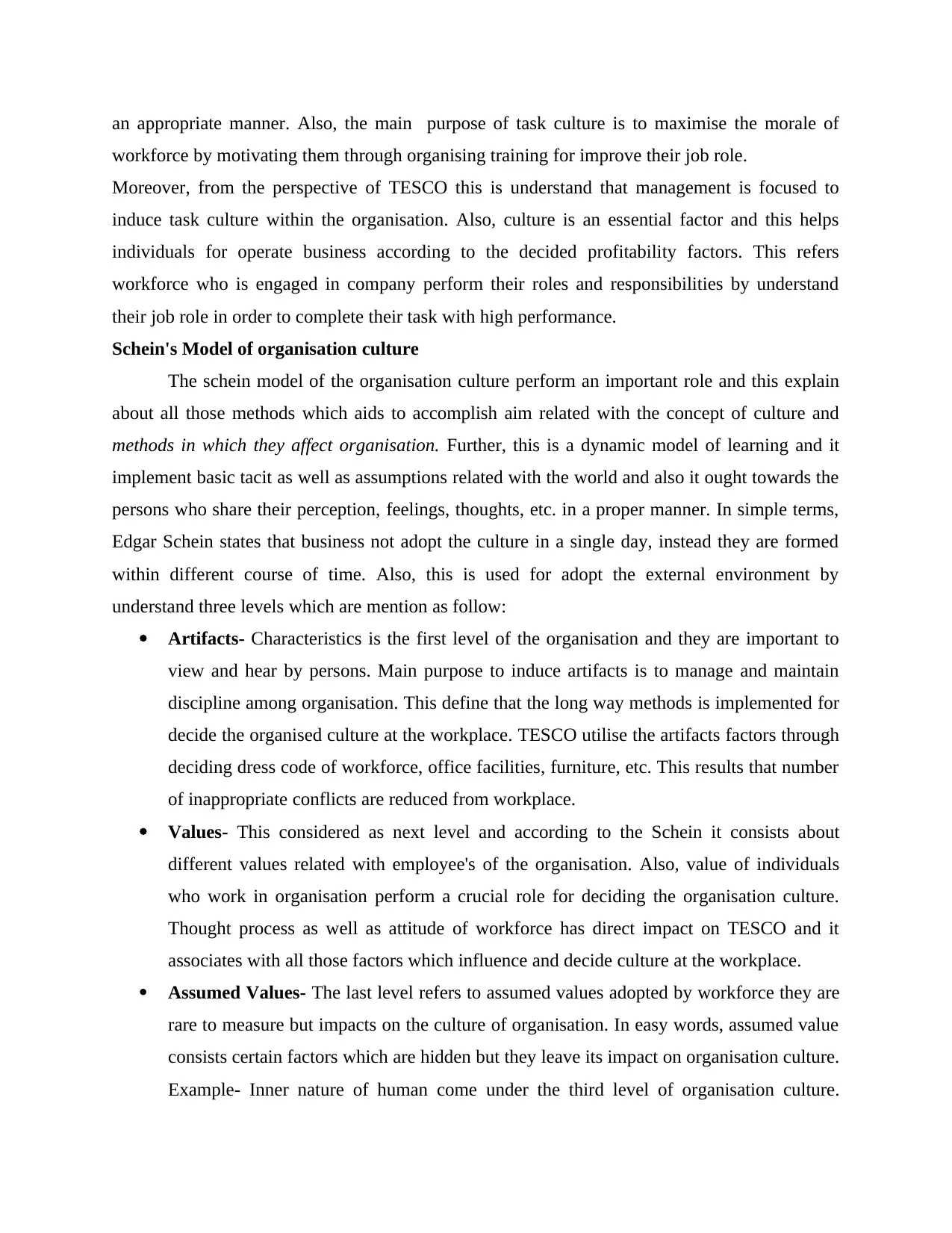
an appropriate manner. Also, the main purpose of task culture is to maximise the morale of
workforce by motivating them through organising training for improve their job role.
Moreover, from the perspective of TESCO this is understand that management is focused to
induce task culture within the organisation. Also, culture is an essential factor and this helps
individuals for operate business according to the decided profitability factors. This refers
workforce who is engaged in company perform their roles and responsibilities by understand
their job role in order to complete their task with high performance.
Schein's Model of organisation culture
The schein model of the organisation culture perform an important role and this explain
about all those methods which aids to accomplish aim related with the concept of culture and
methods in which they affect organisation. Further, this is a dynamic model of learning and it
implement basic tacit as well as assumptions related with the world and also it ought towards the
persons who share their perception, feelings, thoughts, etc. in a proper manner. In simple terms,
Edgar Schein states that business not adopt the culture in a single day, instead they are formed
within different course of time. Also, this is used for adopt the external environment by
understand three levels which are mention as follow:
Artifacts- Characteristics is the first level of the organisation and they are important to
view and hear by persons. Main purpose to induce artifacts is to manage and maintain
discipline among organisation. This define that the long way methods is implemented for
decide the organised culture at the workplace. TESCO utilise the artifacts factors through
deciding dress code of workforce, office facilities, furniture, etc. This results that number
of inappropriate conflicts are reduced from workplace.
Values- This considered as next level and according to the Schein it consists about
different values related with employee's of the organisation. Also, value of individuals
who work in organisation perform a crucial role for deciding the organisation culture.
Thought process as well as attitude of workforce has direct impact on TESCO and it
associates with all those factors which influence and decide culture at the workplace.
Assumed Values- The last level refers to assumed values adopted by workforce they are
rare to measure but impacts on the culture of organisation. In easy words, assumed value
consists certain factors which are hidden but they leave its impact on organisation culture.
Example- Inner nature of human come under the third level of organisation culture.
workforce by motivating them through organising training for improve their job role.
Moreover, from the perspective of TESCO this is understand that management is focused to
induce task culture within the organisation. Also, culture is an essential factor and this helps
individuals for operate business according to the decided profitability factors. This refers
workforce who is engaged in company perform their roles and responsibilities by understand
their job role in order to complete their task with high performance.
Schein's Model of organisation culture
The schein model of the organisation culture perform an important role and this explain
about all those methods which aids to accomplish aim related with the concept of culture and
methods in which they affect organisation. Further, this is a dynamic model of learning and it
implement basic tacit as well as assumptions related with the world and also it ought towards the
persons who share their perception, feelings, thoughts, etc. in a proper manner. In simple terms,
Edgar Schein states that business not adopt the culture in a single day, instead they are formed
within different course of time. Also, this is used for adopt the external environment by
understand three levels which are mention as follow:
Artifacts- Characteristics is the first level of the organisation and they are important to
view and hear by persons. Main purpose to induce artifacts is to manage and maintain
discipline among organisation. This define that the long way methods is implemented for
decide the organised culture at the workplace. TESCO utilise the artifacts factors through
deciding dress code of workforce, office facilities, furniture, etc. This results that number
of inappropriate conflicts are reduced from workplace.
Values- This considered as next level and according to the Schein it consists about
different values related with employee's of the organisation. Also, value of individuals
who work in organisation perform a crucial role for deciding the organisation culture.
Thought process as well as attitude of workforce has direct impact on TESCO and it
associates with all those factors which influence and decide culture at the workplace.
Assumed Values- The last level refers to assumed values adopted by workforce they are
rare to measure but impacts on the culture of organisation. In easy words, assumed value
consists certain factors which are hidden but they leave its impact on organisation culture.
Example- Inner nature of human come under the third level of organisation culture.
⊘ This is a preview!⊘
Do you want full access?
Subscribe today to unlock all pages.

Trusted by 1+ million students worldwide
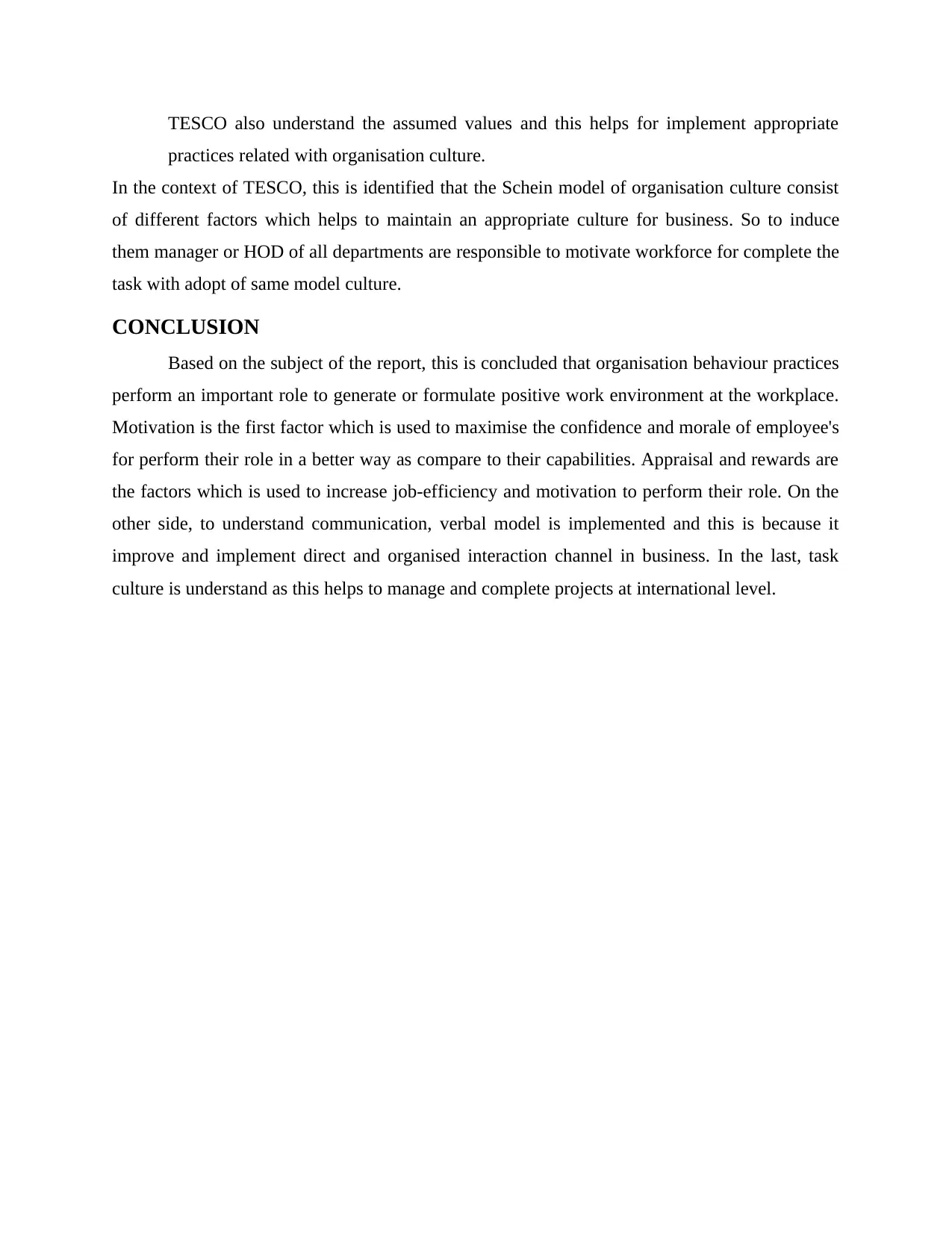
TESCO also understand the assumed values and this helps for implement appropriate
practices related with organisation culture.
In the context of TESCO, this is identified that the Schein model of organisation culture consist
of different factors which helps to maintain an appropriate culture for business. So to induce
them manager or HOD of all departments are responsible to motivate workforce for complete the
task with adopt of same model culture.
CONCLUSION
Based on the subject of the report, this is concluded that organisation behaviour practices
perform an important role to generate or formulate positive work environment at the workplace.
Motivation is the first factor which is used to maximise the confidence and morale of employee's
for perform their role in a better way as compare to their capabilities. Appraisal and rewards are
the factors which is used to increase job-efficiency and motivation to perform their role. On the
other side, to understand communication, verbal model is implemented and this is because it
improve and implement direct and organised interaction channel in business. In the last, task
culture is understand as this helps to manage and complete projects at international level.
practices related with organisation culture.
In the context of TESCO, this is identified that the Schein model of organisation culture consist
of different factors which helps to maintain an appropriate culture for business. So to induce
them manager or HOD of all departments are responsible to motivate workforce for complete the
task with adopt of same model culture.
CONCLUSION
Based on the subject of the report, this is concluded that organisation behaviour practices
perform an important role to generate or formulate positive work environment at the workplace.
Motivation is the first factor which is used to maximise the confidence and morale of employee's
for perform their role in a better way as compare to their capabilities. Appraisal and rewards are
the factors which is used to increase job-efficiency and motivation to perform their role. On the
other side, to understand communication, verbal model is implemented and this is because it
improve and implement direct and organised interaction channel in business. In the last, task
culture is understand as this helps to manage and complete projects at international level.
Paraphrase This Document
Need a fresh take? Get an instant paraphrase of this document with our AI Paraphraser
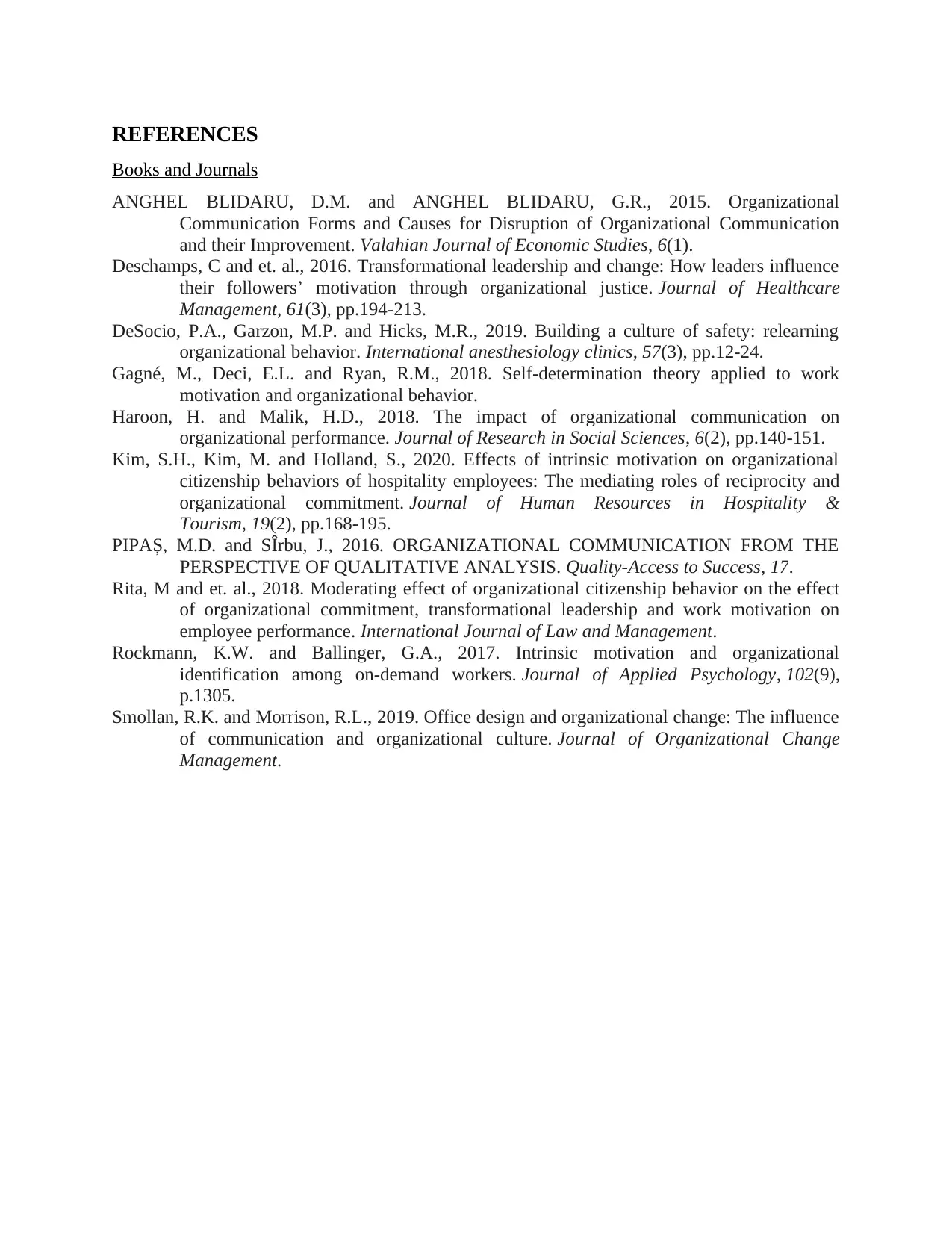
REFERENCES
Books and Journals
ANGHEL BLIDARU, D.M. and ANGHEL BLIDARU, G.R., 2015. Organizational
Communication Forms and Causes for Disruption of Organizational Communication
and their Improvement. Valahian Journal of Economic Studies, 6(1).
Deschamps, C and et. al., 2016. Transformational leadership and change: How leaders influence
their followers’ motivation through organizational justice. Journal of Healthcare
Management, 61(3), pp.194-213.
DeSocio, P.A., Garzon, M.P. and Hicks, M.R., 2019. Building a culture of safety: relearning
organizational behavior. International anesthesiology clinics, 57(3), pp.12-24.
Gagné, M., Deci, E.L. and Ryan, R.M., 2018. Self-determination theory applied to work
motivation and organizational behavior.
Haroon, H. and Malik, H.D., 2018. The impact of organizational communication on
organizational performance. Journal of Research in Social Sciences, 6(2), pp.140-151.
Kim, S.H., Kim, M. and Holland, S., 2020. Effects of intrinsic motivation on organizational
citizenship behaviors of hospitality employees: The mediating roles of reciprocity and
organizational commitment. Journal of Human Resources in Hospitality &
Tourism, 19(2), pp.168-195.
PIPAȘ, M.D. and SÎrbu, J., 2016. ORGANIZATIONAL COMMUNICATION FROM THE
PERSPECTIVE OF QUALITATIVE ANALYSIS. Quality-Access to Success, 17.
Rita, M and et. al., 2018. Moderating effect of organizational citizenship behavior on the effect
of organizational commitment, transformational leadership and work motivation on
employee performance. International Journal of Law and Management.
Rockmann, K.W. and Ballinger, G.A., 2017. Intrinsic motivation and organizational
identification among on-demand workers. Journal of Applied Psychology, 102(9),
p.1305.
Smollan, R.K. and Morrison, R.L., 2019. Office design and organizational change: The influence
of communication and organizational culture. Journal of Organizational Change
Management.
Books and Journals
ANGHEL BLIDARU, D.M. and ANGHEL BLIDARU, G.R., 2015. Organizational
Communication Forms and Causes for Disruption of Organizational Communication
and their Improvement. Valahian Journal of Economic Studies, 6(1).
Deschamps, C and et. al., 2016. Transformational leadership and change: How leaders influence
their followers’ motivation through organizational justice. Journal of Healthcare
Management, 61(3), pp.194-213.
DeSocio, P.A., Garzon, M.P. and Hicks, M.R., 2019. Building a culture of safety: relearning
organizational behavior. International anesthesiology clinics, 57(3), pp.12-24.
Gagné, M., Deci, E.L. and Ryan, R.M., 2018. Self-determination theory applied to work
motivation and organizational behavior.
Haroon, H. and Malik, H.D., 2018. The impact of organizational communication on
organizational performance. Journal of Research in Social Sciences, 6(2), pp.140-151.
Kim, S.H., Kim, M. and Holland, S., 2020. Effects of intrinsic motivation on organizational
citizenship behaviors of hospitality employees: The mediating roles of reciprocity and
organizational commitment. Journal of Human Resources in Hospitality &
Tourism, 19(2), pp.168-195.
PIPAȘ, M.D. and SÎrbu, J., 2016. ORGANIZATIONAL COMMUNICATION FROM THE
PERSPECTIVE OF QUALITATIVE ANALYSIS. Quality-Access to Success, 17.
Rita, M and et. al., 2018. Moderating effect of organizational citizenship behavior on the effect
of organizational commitment, transformational leadership and work motivation on
employee performance. International Journal of Law and Management.
Rockmann, K.W. and Ballinger, G.A., 2017. Intrinsic motivation and organizational
identification among on-demand workers. Journal of Applied Psychology, 102(9),
p.1305.
Smollan, R.K. and Morrison, R.L., 2019. Office design and organizational change: The influence
of communication and organizational culture. Journal of Organizational Change
Management.

⊘ This is a preview!⊘
Do you want full access?
Subscribe today to unlock all pages.

Trusted by 1+ million students worldwide
1 out of 12
Related Documents
Your All-in-One AI-Powered Toolkit for Academic Success.
+13062052269
info@desklib.com
Available 24*7 on WhatsApp / Email
![[object Object]](/_next/static/media/star-bottom.7253800d.svg)
Unlock your academic potential
Copyright © 2020–2025 A2Z Services. All Rights Reserved. Developed and managed by ZUCOL.




